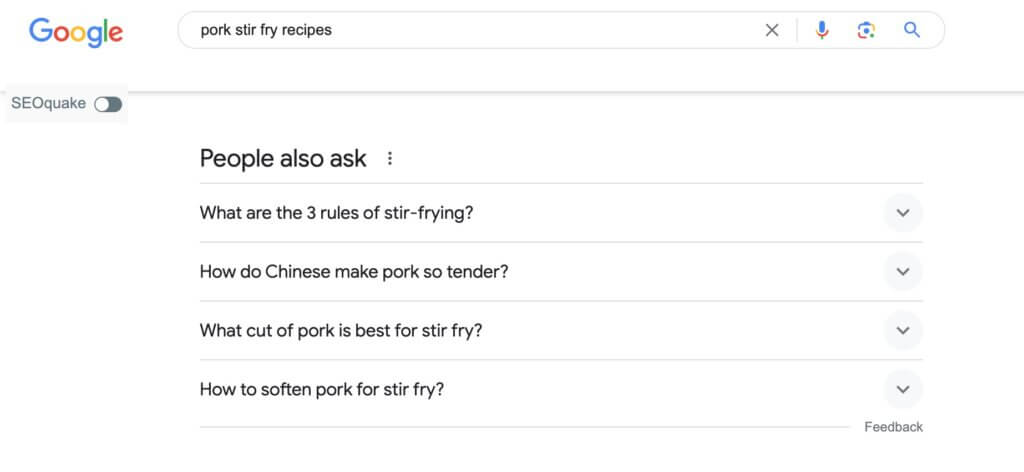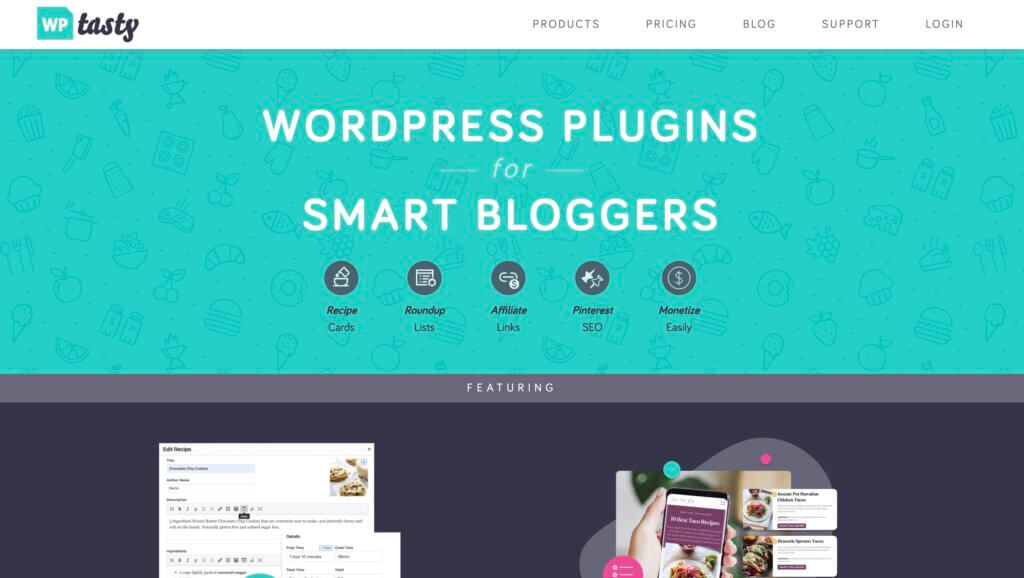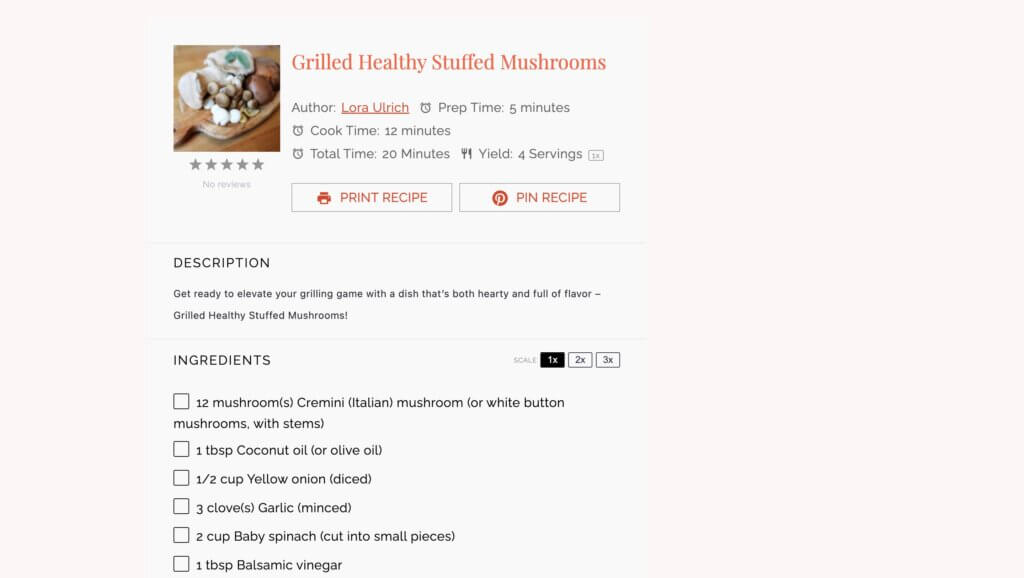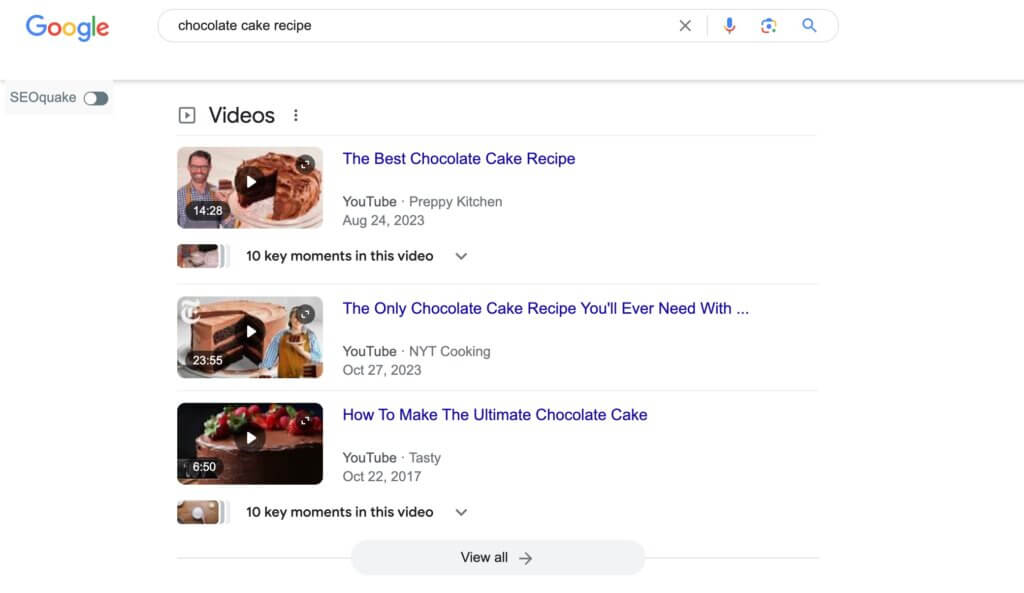Want your recipes to appear 1st in Google searches?
It’s possible, but your recipes need to be more than just delicious it requires a savvy approach to SEO and a keen eye for engaging content.
In this article, we’ll explore SEO tips and tricks for food bloggers to help make your blog more visible and improve your readers’ experience.
Step 1: Make Your Recipes Stand Out from Others
Make people love your website. Does your recipe article answer all the necessary questions a reader might have? Do you have great visuals?
SEO is simple, create better content than your competitors and you will be more likely to rank on page 1.
1. Personalize the Introduction and Conclusion
Kick off each recipe with a personalized introduction. Here, you can dive into the nutritional benefits, share why this recipe is a staple in your diet, or how it complements a healthy lifestyle. Wrap up with a conclusion that reflects on your experiences with the dish, offers serving tips, or suggests pairings. This personal touch not only differentiates your content but also builds a deeper connection with your readers.
2. Modify Ingredients or Portions
Tweak the recipes by substituting ingredients with healthier alternatives or adjusting portions to suit specific dietary needs. This slight alteration not only crafts a unique recipe but also showcases your expertise in crafting balanced meals.
3. Add Unique Nutritional Commentary
Dedicate a section to discuss the nutritional powerhouse behind the key ingredients or the dish as a whole. Highlighting the health benefits specific to your expertise not only sets your content apart but also enriches your readers’ knowledge.
4. Incorporate Original Photos and Videos
Nothing says unique like original visuals. Snap lively photos and record engaging videos of the cooking process or the beautifully plated final product. These authentic visuals captivate your audience and ensure your recipes stand out.
5. Create Custom Serving Suggestions
Offer inventive serving suggestions or variations on the recipe. Whether it’s making the dish vegan, gluten-free, or appealing to children, these adjustments cater to a broader audience and add a layer of uniqueness to your content.
6. Share Personal Stories or Testimonials
Weave in personal anecdotes related to the recipe or share testimonials from those who’ve tasted the dish. These stories add a human element to your post, making your content memorable and uniquely yours.

Step 2: Start Each Recipe With Keyword Research
Embrace Long-Tail Keywords for Recipes
The realm of online recipes is vast and varied, making it a challenge for food bloggers to cut through the noise and reach their intended audience. This is where the magic of long-tail keywords comes into play. Long-tail keywords are longer, more specific phrases that visitors are likely to use when they’re closer to a point-of-purchase or when they’re using voice search. For niche topics like recipes, these keywords are invaluable as they allow you to target specific interests, dietary requirements, or culinary styles that may not be as heavily saturated.
Significance of Long-Tail Keywords for Recipes:
- Targeted Audience: Long-tail keywords help you attract a more targeted audience looking for exactly what you offer. For instance, instead of “cake recipes,” a long-tail keyword like “vegan gluten-free chocolate cake recipe” narrows down the search to a specific audience.
- Lower Competition: These keywords typically have lower competition than more generic terms, making it easier for your blog to rank higher in search results.
- Higher Conversion Rates: Visitors finding your site through long-tail searches are often further along in their decision-making process, leading to higher conversion rates.
Step-by-Step Guide on Conducting Keyword Research:
- Start with a Seed List: Begin by brainstorming a list of broad topics related to your niche that your target audience might search for. For a food blog, this could include types of cuisine, dietary restrictions, meal types, or specific ingredients.
- Use Keyword Research Tools: Leverage tools like Google’s Keyword Planner, Ahrefs, or SEMrush to find long-tail variations of your seed keywords. These tools can provide data on search volume, competition level, and related queries.
- Analyze Search Intent: Understanding the intent behind the search terms is crucial. Are people looking for recipes, ingredient lists, nutritional information, or cooking techniques? Tailor your content to match this intent.
- Check Out the Competition: Search for your long-tail keywords and see what content is currently ranking. Look for gaps that your blog could fill or ways to create more comprehensive or engaging content than what’s already available.
- Refine and Repeat: Keyword research is not a one-time task. Regularly update your keyword list based on current trends, seasonal interests, and emerging dietary preferences.
For a more detailed guide on keyword research, consider referring to authoritative sources or guides, such as Creative SEO Coach’s guide on doing keyword research. This can provide you with a comprehensive understanding and actionable steps to refine your strategy and ensure your content reaches its intended audience effectively.

Step 3. Utilizing the “People also ask” Section for Content Ideas
When crafting content for your food blog, a strategic approach to incorporating commonly asked questions can significantly boost your SEO performance and user engagement. Here’s how you can leverage the “People also ask” section on Google to enrich your content and possibly earn a spot in the coveted featured snippets.
The “People also ask” (PAA) box is a treasure trove of user-curiosity-driven queries related to your main topic. Here’s how to utilize it:
- Search for Your Main Keyword: Begin by typing the primary keyword of your recipe into Google’s search bar. This could be as simple as “chocolate cake” or as specific as “vegan chocolate cake recipe.”
- Explore the PAA Box: Look for the “People also ask” box that appears in the search results. This box expands to show a range of related questions that real users have searched for.
- Gather Relevant Questions: Select questions that are directly related to your recipe or the culinary techniques it involves. These questions can guide the supplemental content you create around your recipe, offering additional value to your readers.
How Answering These Questions Can Improve Your Chances of Getting Featured in Snippets
- Direct Answers to User Queries: By directly answering these questions in your content, you’re providing the exact information users are searching for, which is what Google aims to feature in snippets.
- Structured Content: Structuring your answers in a clear, concise manner (using bullet points, numbered lists, or short paragraphs) makes it easier for Google’s algorithm to identify and extract the information for snippets.
- Keyword Optimization: Incorporate relevant long-tail keywords into your answers. This not only improves your SEO but also increases the likelihood of your content matching a wider array of user queries.
- Enhanced User Experience: Providing comprehensive answers to these questions can significantly enhance the user experience, keeping visitors on your page longer. Google recognizes this positive engagement signal and may reward your content with higher visibility.
- Use Subheadings for Each Question: Format each question as a subheading within your content. This organizational strategy helps search engines understand the structure of your content and identify relevant sections for featured snippets.
By thoughtfully answering common questions related to your recipe, you not only enrich your content but also significantly increase your chances of being featured in Google’s snippets. This visibility can drive more traffic to your blog, establishing your site as a go-to resource for culinary knowledge and expertise.

Step 4. The Role of High-Quality Images and Videos in SEO for Food Blogs
High-quality, mouth-watering images and engaging videos play a pivotal role in the success of food blogs, both from a user engagement and SEO perspective. Here’s why these elements are crucial and how you can optimize them for better search engine visibility.
- Enhanced Engagement: Visually appealing images and videos can capture the attention of your audience, making them more likely to spend time on your page and interact with your content. This increased engagement signals to search engines that your content is valuable, potentially boosting your rankings.
- Increased Shares: High-quality visuals are more likely to be shared on social media, driving additional traffic to your blog. Social signals can indirectly influence your SEO performance by increasing your content’s visibility and reach.
- Visual Searches: With the rise of visual search technologies, your images and videos can appear in visual search results, leading more visitors to your blog. Optimizing these visuals ensures they’re discoverable through search engines like Google Images.
Tips for Optimizing Images and Videos for SEO
- Use Descriptive File Names: Instead of generic filenames, use descriptive, keyword-rich names for your images and videos. For example, “vegan-chocolate-cake.jpg” tells search engines and users what the image depicts, improving its discoverability.
- Alt Tags Are Essential: Alt tags provide a text alternative for images on your blog. Including relevant keywords in your alt tags helps search engines understand the content of your images, enhancing your SEO. For example,
alt="easy homemade vegan chocolate cake"can improve the image’s ranking for those searching for vegan chocolate cake recipes. - Optimize Image and Video Sizes: Large files can slow down your website, negatively impacting user experience and SEO. Compress images and videos to reduce their file size without sacrificing quality. Tools like Adobe Photoshop, TinyPNG, or HandBrake for videos can help with this.
- Use Responsive Images: Ensure your images and videos are mobile-friendly. Using responsive design techniques allows visuals to adjust based on the user’s device, improving the user experience and SEO.
- Include Captions: While not directly impacting SEO, captions can enhance user engagement by providing context for the image or video. Engaged users are more likely to spend more time on your site, which is a positive signal to search engines.
- Structured Data for Videos: For videos, consider using schema markup to provide search engines with more information about your video content. This can include the video’s title, description, duration, and thumbnail. Video schema markup can enhance your presence in search results, especially for recipe videos.
By following these tips, you can ensure that your images and videos not only captivate your audience but also contribute to your blog’s SEO performance. High-quality visuals are not just eye candy; they are an integral part of a successful SEO strategy for food blogs, helping to attract more visitors and keep them engaged with your content.
Step 5. Utilize Schema Markup for Recipes
Explanation of Schema Markup and Its Benefits for Recipes
Schema Markup is a form of microdata added to a webpage to create an enhanced description (commonly known as a rich snippet) that appears in search results. For food bloggers, implementing Recipe Schema Markup is a game-changer. It helps search engines understand the content of your recipes, including ingredients, cooking time, calories, and more, presenting this data in an organized and appealing way directly in search results.
Benefits:
- Enhanced Visibility: Recipes with Schema Markup stand out in search results, thanks to rich snippets that might display images, ratings, prep times, and more, making your recipes more clickable.
- Better Understanding: It helps search engines understand your content better, which can improve how your page is indexed and ranked.
- Increased Engagement: Users get valuable information at a glance (like cooking time or calorie count), which can improve click-through rates and user engagement.
How to Implement Recipe Schema to Enhance Visibility in Search Results
- Use a Structured Data Markup Tool: Tools like Google’s Structured Data Markup Helper can guide you through the process of creating your Schema Markup. Select the type of data (in this case, “Recipe”) and paste the URL of your recipe post. The tool will allow you to tag different elements of your recipe, such as ingredients and cooking times.
- Add the Markup to Your Webpage: Once you’ve tagged your data, the tool will generate the HTML code with the appropriate Schema Markup. You’ll need to add this code to the HTML of your recipe page. If you’re using a content management system (CMS) like WordPress, there are plugins that can simplify this process.
- Test Your Markup: After implementing your Schema Markup, use Google’s Rich Results Test to verify that Google can read the markup correctly. This tool will show you how your recipe might appear in search results and alert you to any errors in your markup.
- Monitor Performance: Use Google Search Console to monitor how your recipes are performing in search results. Look for increases in impressions and click-through rates as indicators of success.
Implementing Recipe Schema Markup requires a bit of technical know-how, but the payoff in search visibility and user engagement can be substantial. By providing search engines with detailed information about your recipes, you’re not just enhancing the presentation of your recipes in search results; you’re also improving the overall discoverability of your food blog.
Including nutritional information in your recipes can significantly enhance the value of your content for readers, improving both user engagement and search rankings. Here’s why it matters and how it can benefit your food blog.

5. The Significance of Including Nutritional Information
- Health-Conscious Readers: With a growing focus on health and wellness, many readers are looking for nutritional details to help them make informed dietary choices. Providing this information meets a critical need, making your recipes more appealing to a health-conscious audience.
- Comprehensive Content: Recipes that come with detailed nutritional information are seen as more complete and trustworthy. This level of detail can set your blog apart from competitors and position you as a go-to source for well-researched recipes.
- Dietary Restrictions and Preferences: For individuals with dietary restrictions or those following specific diets (like keto, vegan, or gluten-free), nutritional information is essential. It enables them to easily determine if a recipe meets their dietary needs.
How Nutritional Information Can Improve Search Rankings and User Engagement
- Rich Snippets and SEO: Including structured nutritional information in your recipes can make them eligible for rich snippets in search results. Recipes with rich snippets often have higher click-through rates as they provide key information (such as calorie counts) directly in the search results.
- Increased Time on Page: Readers are likely to spend more time on your recipe page as they review the nutritional details, contributing to better on-page engagement metrics. Search engines interpret longer dwell times as a signal of content quality, which can positively influence your rankings.
- Social Sharing: Recipes with comprehensive nutritional information are more likely to be shared, especially within communities focused on health, fitness, and specific diets. This social validation not only drives traffic but can also positively impact your search visibility.
To implement nutritional information effectively, consider using a standardized format that clearly lists calories, macronutrients (carbohydrates, proteins, fats), and any other relevant information such as sugar, fiber, and sodium content. Tools and plugins designed for food blogs can automate much of this process, ensuring accuracy and consistency across your recipes.
For an example of how nutritional information can be seamlessly integrated into recipes, check out Lora Ulrich’s recipes. This site provides a practical demonstration of how detailed nutritional information can be presented alongside delicious, health-conscious recipes, enhancing the overall value and appeal of the content.
By incorporating nutritional details into your recipes, you not only enrich your content but also cater to the evolving needs and preferences of your audience, potentially improving your site’s SEO performance and user engagement.
6. Best SEO Plugins for Food Blogs
- Yoast SEO: Yoast SEO is a comprehensive solution that helps you optimize your site’s content, titles, meta descriptions, and more. While not exclusively for food blogs, its readability and keyword optimization features are invaluable for any content creator.
- Rank Math: This plugin offers a suite of features to improve your site’s SEO, including sitemap generation, rich snippets, and content analysis. Its user-friendly interface and powerful optimization tools make it a favorite among bloggers.
- WP Recipe Maker: Specifically designed for food blogs, WP Recipe Maker allows you to easily add recipes to your posts. It includes features for adding nutritional information, cooking times, and even integrates with Google’s Recipe View for enhanced visibility in search results.
For an in-depth guide on utilizing these plugins and maximizing your food blog’s SEO potential, consider visiting resources like Creative SEO Coach, which offers tailored advice and tutorials.
Highlight Features of Recommended Plugins like WP Tasty for Recipe Optimization
WP Tasty:
- Recipe SEO Optimization: WP Tasty provides structured data support to help your recipes appear as rich snippets in search results. This includes details like ingredients, cooking time, and nutritional information.
- Automatic Nutrition Facts: The plugin can auto-generate nutritional facts for your recipes, a key feature for attracting health-conscious readers.
- User Ratings: WP Tasty allows readers to leave ratings on your recipes, which can encourage more interaction and provide social proof to new visitors.
Utilizing SEO plugins like WP Tasty can transform how your recipes are discovered and engaged with online. By integrating these tools into your food blog, you not only streamline your content creation process but also significantly boost your SEO efforts, ensuring that your recipes reach and delight more food lovers.
For more detailed guidance on selecting and using SEO plugins for your food blog, exploring specialized resources dedicated to the blogging community, such as Creative SEO Coach, can provide you with tailored strategies and insights.

7. Basic SEO Strategies for Food Bloggers
For every food blogger eager to climb the SEO ladder, embracing basic SEO practices is essential. These foundational strategies not only boost your blog’s visibility but also enhance user engagement and site performance. Here’s a brief rundown of the basic SEO strategies that should be on every food blogger’s checklist, along with the importance of mobile optimization, site speed, and user experience.
- Keyword Research: Identify the right keywords that your target audience is searching for. This includes both short-tail and long-tail keywords relevant to your recipes and food content.
- Quality Content: Create high-quality, original content that provides value to your readers. This includes detailed recipes, cooking tips, nutritional information, and engaging stories about your culinary adventures.
- On-Page Optimization: Ensure that each page on your blog is optimized for SEO. This includes using the right keywords in your titles, headings, meta descriptions, alt tags for images, and throughout your content.
- Mobile Optimization: With the majority of internet users accessing content via mobile devices, ensuring your blog is mobile-friendly is crucial. A responsive design that adapts to different screen sizes can significantly improve the user experience.
- Site Speed: Page load time is a critical factor for both SEO and user experience. Optimize images, leverage browser caching, and minimize code to speed up your website.
- Internal Linking: Use internal links to connect your content and guide users through your website. This not only helps with SEO but also increases the time visitors spend on your site.
- Social Sharing: Incorporate social sharing buttons on your blog posts to encourage readers to share your content. Social signals can indirectly impact your blog’s SEO performance.
- Regular Updates: Keep your content fresh and up-to-date. Regular updates signal to search engines that your site is active, which can help maintain or improve your rankings.
For a more comprehensive guide on implementing these basic SEO strategies, consider referring to a detailed resource, such as the Creative SEO Coach’s basic SEO guide, which is specifically designed to help food bloggers navigate the complexities of SEO.
The Importance of Mobile Optimization, Site Speed, and User Experience
- Mobile Optimization: Essential for reaching a wider audience, as more people now use mobile devices for web browsing than desktops. Google’s mobile-first indexing also prioritizes mobile-optimized sites in its search results.
- Site Speed: Critical for keeping visitors on your site. Slow-loading pages lead to higher bounce rates and can negatively impact your search rankings. Tools like Google PageSpeed Insights can provide insights and recommendations for improving your site’s speed.
- User Experience: A seamless user experience keeps visitors engaged and reduces bounce rates. This includes easy navigation, fast load times, and mobile-friendly layouts. An excellent user experience can lead to higher conversions, more shares, and improved SEO rankings.
By focusing on these basic SEO practices, food bloggers can significantly enhance their site’s visibility in search engine results, attracting more visitors and creating a loyal readership base. Remember, SEO is a long-term strategy, and consistent effort in optimizing your blog will yield rewarding results over time.

8. Do You Have to Write a Long Copy Before the Recipe to Rank for SEO?
The debate around the necessity and effectiveness of long content before a recipe has been a hot topic among food bloggers and SEO experts alike. The question boils down to whether this strategy is essential for improving your search engine rankings and engaging your readers, or if it’s possible to achieve SEO success without it.
The Case for Long Content
Evidence suggests that long-form content tends to rank well on search engines. Google’s own advice hints at a preference for in-depth articles, indicating that users’ needs for comprehensive understanding of broad topics are recognized and rewarded in search rankings. Moreover, long-form content is known to attract more backlinks, a crucial factor for SEO success. These backlinks not only enhance your blog’s authority but also significantly improve its visibility in search results.
The SEO Benefits
Long content before a recipe allows for the incorporation of relevant keywords, answering frequently asked questions, and providing valuable insights that can’t be covered in the recipe alone. This not only aids in satisfying the search intent of your readers but also signals to search engines that your content is a comprehensive resource on the topic.
User Engagement and Conversion
Beyond SEO, long-form content can positively impact user engagement and conversion rates. Detailed content that answers readers’ questions fully and provides extensive insights tends to keep visitors on your page longer, reducing bounce rates and increasing the likelihood of conversions, whether it’s signing up for a newsletter or trying more recipes.
But Is It Always Necessary?
While the benefits of long content are clear, it’s crucial to note that not every recipe post requires an essay before getting to the point. The key is relevance and value. If the information before the recipe adds value for the reader and enhances their understanding or enjoyment of the recipe, it’s likely to be beneficial. However, filler content that serves no purpose other than to pad the article length may do more harm than good, potentially frustrating readers and diluting the quality of your content.
The Verdict
Ultimately, whether you choose to write long copy before a recipe should depend on the unique needs of your audience and the specific goals of your blog. Striking the right balance between providing valuable, SEO-friendly content and maintaining an engaging, reader-friendly format is essential. Remember, quality always trumps quantity. Ensuring that any pre-recipe content is engaging, informative, and relevant will serve your SEO objectives and keep your readers coming back for more.
9. Best Marketing Techniques For Your Recipe Blog
When it comes to recipe blogging succes engaging content is key. With 4 out of 5 Generation Z adults enjoying food content on social media, the audience’s engagement with food blogs is high, underlining the importance of creating visually appealing and informative content.
Here’s a simple strategy to expand your blog’s reach and make your recipes even more popular.
Create and Share Videos
Film Your Cooking Process: People love watching food being prepared. It’s not just about the final dish but the journey to create it. Consider filming yourself while cooking the recipes you blog about. This adds a personal touch and helps viewers connect with you.
YouTube: Once you’ve filmed your recipe, upload the video to YouTube. YouTube is the second largest search engine, and having your content here can help you reach a wider audience. Make sure to link back to your blog in the video description.
Embed Videos in Your Articles: Adding the video you made into your blog posts can enhance your readers’ experience. It provides them with a visual guide to follow, which can be particularly helpful for complex recipes or techniques.
Utilize Social Media
Short-Form Content for Social Media: Platforms like Instagram, TikTok, and Facebook are perfect for sharing short clips from your cooking videos. Use a tool to edit your videos into bite-sized pieces that highlight the most interesting or important steps of your recipe. These short clips can drive curiosity and lead viewers back to your blog for the full recipe and video.
Engage With Your Audience: Social media isn’t just for posting; it’s also for engaging. Respond to comments, ask for feedback, and encourage your followers to share their own attempts at your recipes. Engagement can increase your visibility on these platforms.
Why This Works
Engaging content is essential, as a significant portion of Generation Z enjoys interacting with food content on social media. By creating visually appealing and informative content across different channels, you’re not only meeting your audience where they spend their time but also providing value that encourages interaction and sharing.
These strategies not only help in enhancing your blog’s SEO but also play a crucial role in building a community around your food blog. By diversifying your content and engaging with your audience across multiple platforms, you’re setting the stage for sustained growth and a deeper connection with your readers.

